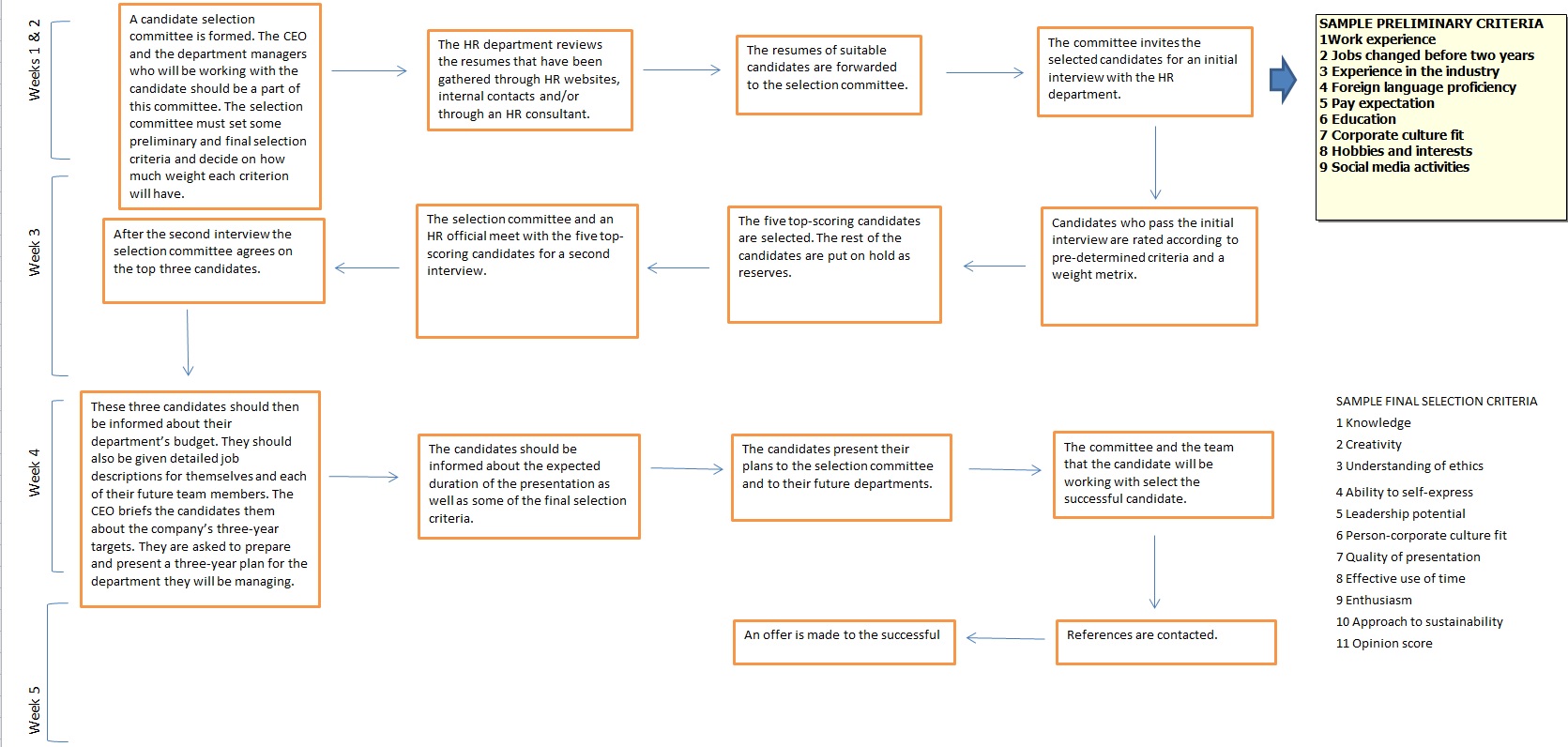A framework for assessing “fit” when hiring managers.
Dr. İzel Levi Coşkun
Companies appear to follow similar processes when hiring senior-level managers. The first stage is the gathering of resumes through contacts, HR websites and advisers as well as from the CVs held by their HR departments. The second stage consists of the elimination of unsuitable candidates by studying their resumes, or through interviews. Suitable candidates who make it through to the final round are then invited for an interview with the general director or another senior official. Finally the most likely candidate is invited for a further interview. If that final interview is a success, negotiations over pay and benefits begin. The successful candidate is then hired, following the approval of the general director or partners.
A large number of executive resumes I receive list frequent job changes. When I ask candidates why they left –or are thinking of leaving- their previous job I typically hear the following answers: “There was no room for self-development,” “I am not allowed to take the initiative,” “The promises made were not kept” or “The workplace is very different to what I had imagined, it is not for me.” A survey carried out by Gallup summarises the top voluntary job-related reasons for changing jobs as follows: 31,5% career advancement/promotional opportunities; 22% pay/benefits; 20% lack of fit in job; 16,5% management/general work environment; 8% flexibility/scheduling and 2% job security.[1]
I believe these problems result partly from the initial hiring process where the person-job fit criteria (based on the compatibility between a person’s competence and the requirements of the job) are given more emphasis than person-organisation or person – superior/subordinate fit.[2]
Another problem I have identified with the resumes of pretty much all senior professionals with a certain level of experience is that they have –at least once- worked in a company for less than a year, or in some cases for only a couple of months. Have you ever thought about the magnitude of the economic, social and environmental burden that results from having a recently-hired manager leave due to a lack of fit?
Research carried out by SHRM (Society For Human Resource Management) suggests that cost of turnover as a result of poor cultural fit can reach as high as 60% of an employee’s annual salary.[3] All that investment the company made in their employee; training costs, lost time, negativity experienced by both the manager and the company; the cost of going through the same process once again; the psychological impact on both the manager and the company and the unnecessary carbon footprint…
At this point I intend to talk about three dimensions of “fit”: person-corporate culture fit; person-subordinate fit and person-superior fit. These dimensions are harder to assess compared to the more commonly known person-job fit selection criteria such as knowledge, experience, competence and pay expectations.
Person-corporate culture fit: Cultural fit is defined as the compatibility between a person’s norms and values and those of an organisation. There are two functions of culture that lead to the success or failure of an organisation. Internal fit and coordination make up the first function: these two elements create a feeling of unity. The second function is “a shared system,” which lays the foundation for communication and mutual understanding.[4] This is what makes being compatible with a company’s culture essential for ensuring that a candidate will fulfil other criteria for a successful fit. Of course, in order for this to be possible the company’s purpose and the parameters that define its culture must be stated clearly. They must also be understandable. The purpose of the company must also be in harmony with the candidate’s personality. The candidate needs to be motivated and excited about the purpose of the company; the candidate must see it as part of a set of reasons that will make them want to spend what is possibly a large part of their life at that company. This is why the interview model used should be able to assess this type of fit. We need to remember that if there is a lack of clarity about how corporate culture is defined and explained, and if this is not explicitly communicated to the employees, there is always the risk of making a standard, run of the mill selection.
Person-peer/superior fit: One of the important components of the added value that a candidate may bring to the company depends on how that person works with his or her peers and supervisors as part of a team. Unfortunately, it is not possible to predict whether such a fit will occur between a candidate and their future department managers before they meet. Ensuring that the candidate is introduced to their prospective managers during the initial job interview will give them the opportunity to see and make themselves familiar with colleagues.
Person-team fit: Most interviews are concluded with a senior-level decision, which means that the candidate will only be able to meet his or her colleagues once they start their job. However, the candidate and his or her team will be spending most of their time together and will play a direct role in each other’s success. Any lack of fit within the team would have an adverse effect on both the candidate’s and the team members’ careers.
The section below contains a step-by-step method, which aims to assess, with minimum risk and maximum fairness, a number of dimensions of fit as well as gauging whether the candidate and the company are suitable for each other. Our company has been using this method successfully for almost 5 years now. Although, completion of this selection procedure may take up to a month, we as a company prefer to view this period as an investment in the future rather than a cost item, even when we have urgent personnel needs. We use that time to minimise our risks as a team and to be sure of our choice.
Step 1: An assessment committee is formed. The CEO and the department managers who will be working with the candidate should be a part of this committee. These individuals should include the candidate’s future managers to whom they will be reporting as well as their peers with whom they will have important business relations. A member of the candidate’s prospective team may also be a part of this committee. At our company, the committee set up for the selection process for the post of HR director contained a representative from our HR department. Similarly, during our marketing director selection process prospective team members of the candidate joined the committee during the final interview. The selection committee must set some preliminary and final selection criteria and decide on how much weight each criterion will have. What is of critical importance at this point is to make sure that three separate sets of criteria are created. The first set of criteria should aim to assess person-job fit and to ensure fairness in the elimination of the resumes that the company has received. The aim of the second set should be to assess the candidate’s compatibility with the company. The third set of criteria should measure compatibility with the candidate’s team; these criteria may be a little different in nature from criteria that would be set by senior management. The main goal of the latter is to assess the candidate’s potential to get along with their team members.
Step 2: The HR department reviews the resumes that have been gathered through HR websites, internal contacts and/or through an HR consultant. A crucial point here is to use a consistent set of criteria so that the elimination process is carried out in a fair manner.
Step 3: The resumes of suitable candidates are forwarded to the selection committee.
Step 4: The committee invites the selected candidates for an initial interview with the HR department.
I wish to tell you a personal story at this point. Our company’s culture is open to all suggestions and criticism from employees, regardless of their position and age. Some time ago we needed to fill a vacancy for a director in our HR department. We had our HR experts and assistant experts –both junior than the rank of manager- conduct the initial interview with the candidates. We believed this would allow us to assess cultural fit and subordinate/superior relationship from the start. On hearing that the interview would be carried out in this manner one of the candidates withdrew their application. He sent me a very polite message via LinkedIn saying that he had been in the profession for many years, that he had never seen anything like this and that our methods made him feel quite uncomfortable. As soon I got his message I sent him a reply in which I said that we, as a company, made no claims as to the correctness of our method. I explained to him that our corporate culture required the hiring process to progress in this manner and that the fact that this made him withdraw proved that it had served its purpose by avoiding wasted time.
Step 5: Candidates who pass the initial interview are rated according to pre-determined criteria. At our company, this is the stage where we ask candidates to define sustainable development and ethics, both of which are crucial components of our company’s culture. We also ask candidates to tell us what kind of a work environment they think will help them to thrive. We expect these questions to be answered in writing before the interview. The answers we receive provide us with an insight about the candidate. I have known individuals who defined sustainable development as “continuous growth” and ethics as “absolute compliance with all company rules.” On the other hand, there have been candidates who printed their names and signed the definitions they made, giving us the impression that they stood by their definitions.
Step 6: The five top-scoring candidates are selected. The rest of the candidates are put on hold as reserves. The manner with which a company communicates with these reserve candidates is important and delicate. All candidates, but especially those on the reserve list, must be informed about the rest of the process carefully and politely. Failure to inform the candidates about the result of their interview is a big mistake, which may end up damaging a company’s reputation. For this reason, there have been times at our company where, instead of HR, a committee member or myself has contacted candidates who were not selected.
Step 7: The selection committee and an HR official meet with the five top-scoring candidates for a further interview. It is always worth remembering that a crowded selection committee may be a cause of stress for candidates. Although, it may be possible to use stress as part of the assessment of the candidate, our company prefers not to put them under stress so that they can perform freely. Therefore, we take care to make sure committee members arrive separately and have a little chat with the candidate before they begin their presentation. We also try to make the candidate feel at ease by personally offering them drinks or food.
Step 8: After the second interview the selection committee agrees on the top three candidates.
Step 9: These three candidates should then be informed about their department’s budget. They should also be given detailed job descriptions for themselves and each of their future team members. Once this is done the candidates are asked to prepare and present a three-year plan for the department they will be managing. The committee decides on how much information will be given to the candidates. I personally do not think it is right to expect a candidate to present a business plan –or to start their job, for that matter- without having been given sufficiently detailed information about the budget of the department they will be managing. Similarly, another way of helping the candidate to create a realistic plan is to brief them about the company’s three-year targets. The CEO should preferably do this. Providing the candidate with all relevant information at this stage is crucial. At our company we even give our candidates our business cards and ask them to contact us should they have any questions before they present their plans. This allows the process to be interactive and helps us to get to know the candidates better. The tone they use when asking for information via email or phone, the feedback we receive about our answers and the relationship they try to build, or avoid building, with their department act as important indicators.
Step 10: The candidates should be informed about the expected duration of the presentation as well as some of the final selection criteria. I personally believe that a candidate has the right to be informed about the criteria with which they will be assessed. However, it is also a possibility that such information may tempt some candidates to act as someone other than their true selves; someone who would fit the given criteria better. Therefore, the decision about whether or not to share any of the criteria with the candidate should be made by the committee.
Step 11: The candidates present their plans to the selection committee and to their future departments. The stress problem I have mentioned in step 8 applies here as well. In order to eliminate this problem, the company should act as set out in that section. Most often, candidates strive to present the perfect business plan. What we are trying to do, on the other hand, is to find out about their personalities using clues such as their points of view, presentation styles and how they answer the questions, rather than giving them a challenging task over which they have little command. For example, a candidate who gives vague answers to the questions or avoids giving a clear answer for fear of making mistakes would convince me that they do not fit our company’s culture.
Step 12: The committee agrees on a candidate based on the average of the scores on the evaluation forms. In a recent interview we asked a candidate to grade themselves out of 10 on some of our criteria. We had already approved the candidate and were expecting a positive outcome. We were impressed to see that the result of their self-evaluation was so incredibly close to what we had on our evaluation forms. That made sure that we could offer them the job with peace of mind. Their down-to-earth objectiveness about themselves sent out a clear message that they were indeed who they said they were.
Step 13: References are contacted. I would like to emphasise the importance of this procedure because I am aware of the tendency to skip this step altogether. The usual practice is to contact a candidate’s superiors. In our company we contact some members of the teams that report to the candidate as well as their superiors.
Step 14: An offer is made.
I believe that this 14-step senior manager selection method, which we have been using in our company for a number of years, offers many benefits to companies and candidates alike. It uses mutual communication and empathy in the most efficient way possible to minimise hiring risks. Some steps of the process may be adapted to the needs and facilities of companies. Nevertheless, this method gives the candidate an opportunity to get to know the company better while allowing both the managers and the candidate’s future team to take part in the selection and hiring process. I fully trust that, when used efficiently, this method will act as a solution to some of the fit-related problems that I have mentioned.
Summary
Observation
The first stage of any traditional manager hiring approach is to gather resumes from advisers, HR websites and personal contacts. The first step is to invite candidates for an interview with the HR department. The candidates who pass this initial interview are then invited for a further interview with the general manager. The final step consists of negotiations over pay and benefits as well as contacting references.
Problem
Frequent job changes listed in executive resumes are a very common problem. The economic, social and environmental impact of a recently-hired manager leaving their job because of dissatisfaction is substantial. All that investment that the company made in their employee; training costs, lost time, negativity experienced by both the professional and the company; the cost of going through the same process once again and the psychological impact on the employee.
Solution
In addition to the more commonly known person-job fit criteria for hiring managers such as experience, competence, foreign language proficiency, experience in the industry and pay expectation, “fit,” which is harder to assess, must also be taken into consideration. There are three dimensions of fit: person-corporate culture fit; person- peer/superior fit; person-team fit. The author presents a 14-step guide for assessing fit.
[1] http://www.gallup.com/businessjournal/106912/Turning-Around-Your-Turnover-Problem.aspx?g_source=reasons%20people%20quit%20their%20jobs&g_medium=search&g_campaign=tiles
[2] Amy L. Kristof- Brown Et Al., Consequences of Individuals’ Fit at Work: A Meta-Analysis of Person-Job, Person-Organization, Person-Group and Person-Supervisor Fit, Personnel Psychology, 2005
[3] Katie Botuon, Koya Leadership Partners, HBR, July 2015
[4] Adrian Furnham, The Psychology of Behaviour at Work, Psychology Press, 2005





No Comment